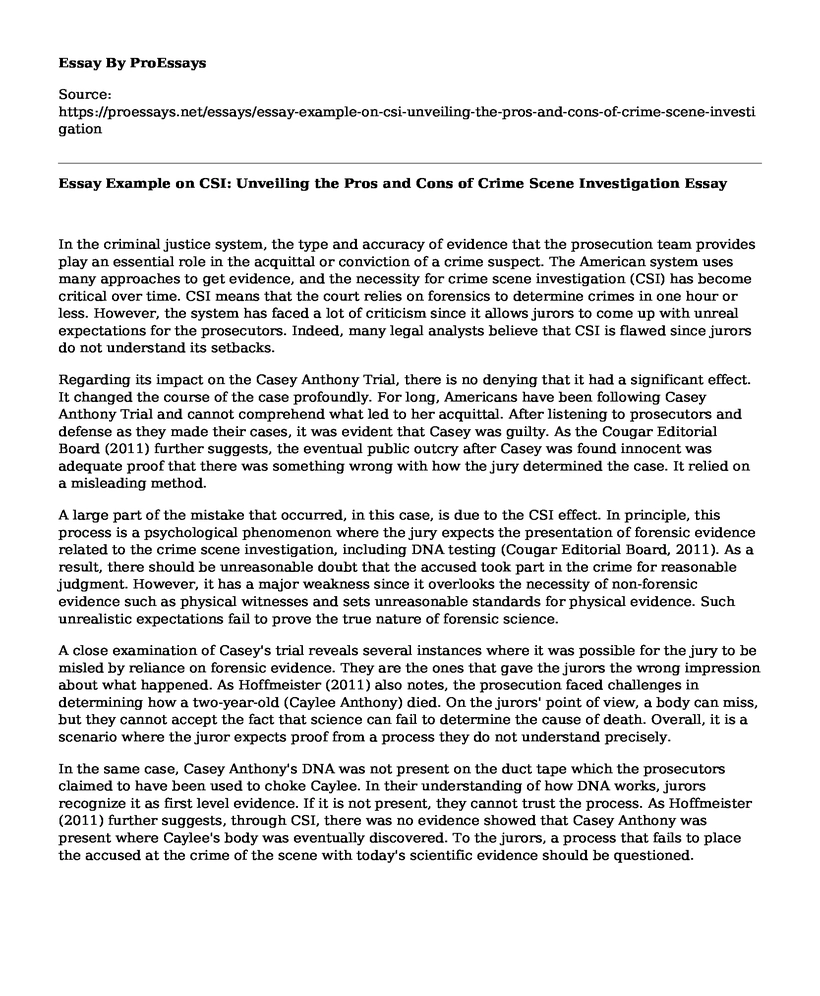In the criminal justice system, the type and accuracy of evidence that the prosecution team provides play an essential role in the acquittal or conviction of a crime suspect. The American system uses many approaches to get evidence, and the necessity for crime scene investigation (CSI) has become critical over time. CSI means that the court relies on forensics to determine crimes in one hour or less. However, the system has faced a lot of criticism since it allows jurors to come up with unreal expectations for the prosecutors. Indeed, many legal analysts believe that CSI is flawed since jurors do not understand its setbacks.
Regarding its impact on the Casey Anthony Trial, there is no denying that it had a significant effect. It changed the course of the case profoundly. For long, Americans have been following Casey Anthony Trial and cannot comprehend what led to her acquittal. After listening to prosecutors and defense as they made their cases, it was evident that Casey was guilty. As the Cougar Editorial Board (2011) further suggests, the eventual public outcry after Casey was found innocent was adequate proof that there was something wrong with how the jury determined the case. It relied on a misleading method.
A large part of the mistake that occurred, in this case, is due to the CSI effect. In principle, this process is a psychological phenomenon where the jury expects the presentation of forensic evidence related to the crime scene investigation, including DNA testing (Cougar Editorial Board, 2011). As a result, there should be unreasonable doubt that the accused took part in the crime for reasonable judgment. However, it has a major weakness since it overlooks the necessity of non-forensic evidence such as physical witnesses and sets unreasonable standards for physical evidence. Such unrealistic expectations fail to prove the true nature of forensic science.
A close examination of Casey's trial reveals several instances where it was possible for the jury to be misled by reliance on forensic evidence. They are the ones that gave the jurors the wrong impression about what happened. As Hoffmeister (2011) also notes, the prosecution faced challenges in determining how a two-year-old (Caylee Anthony) died. On the jurors' point of view, a body can miss, but they cannot accept the fact that science can fail to determine the cause of death. Overall, it is a scenario where the juror expects proof from a process they do not understand precisely.
In the same case, Casey Anthony's DNA was not present on the duct tape which the prosecutors claimed to have been used to choke Caylee. In their understanding of how DNA works, jurors recognize it as first level evidence. If it is not present, they cannot trust the process. As Hoffmeister (2011) further suggests, through CSI, there was no evidence showed that Casey Anthony was present where Caylee's body was eventually discovered. To the jurors, a process that fails to place the accused at the crime of the scene with today's scientific evidence should be questioned.
Conclusion
Overall, the case could have been better determined without depending on CSI. Even though it is crucial to request for adequate evidence to acquit or convict a suspect, reliance on some techniques can be misleading. As a result, the use if CSI led to a scenario where Casey Anthony's case depended on circumstantial evidence since there lacked forensic evidence linking Casey to Caylee's death. Even though many people believe that the prosecutorial team performed exemplary, the judicial systems should understand how forensic evidence works to avoid relying on techniques which can be misleading at times.
References
Cougar Editorial Board. (2011, July 6). Casey Anthony acquitted; 'CSI effect' sways jury. The Cougar. Retrieved from http://thedailycougar.com/2011/07/06/casey-anthony-acquitted-csi-effect-sways-jury/
Hoffmeister, T. (2011, July 7). Did 'CSI' effect sway Anthony jury?. CNN. Retrieved from http://edition.cnn.com/2011/OPINION/07/06/hoffmeister.anthony.jury/index.html
Cite this page
Essay Example on CSI: Unveiling the Pros and Cons of Crime Scene Investigation. (2023, Jan 16). Retrieved from https://proessays.net/essays/essay-example-on-csi-unveiling-the-pros-and-cons-of-crime-scene-investigation
If you are the original author of this essay and no longer wish to have it published on the ProEssays website, please click below to request its removal:
- A Connecticut Yankee in King Arthur's Court: Literary Analysis Essay
- Article Analysis Essay on Reducing Disproportionate Minority Contact in the Juvenile Justice System
- Individuals With Disabilities Education Act Paper Example
- Intellectual Property Court Case Paper Example
- Benefits of Decriminalizing Illicit Substances in Canada - Essay Sample
- Essay Example on Obama Care in Texas: Potential Issues and Challenges
- Essay Example on 19th Century Identification & Crime Investigation







